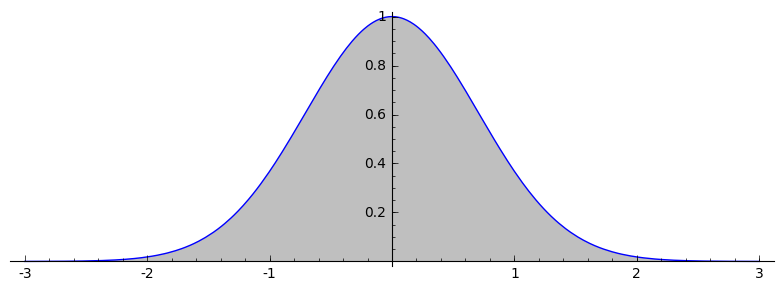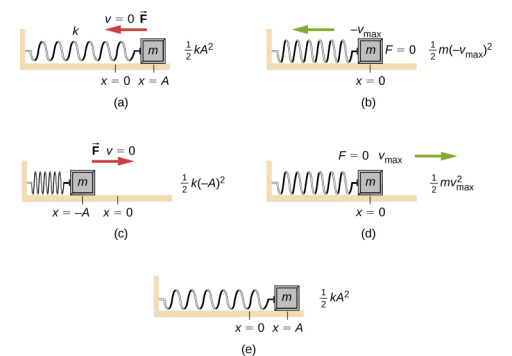Your favorite formula
(5pts)
I assume that you couldn't have made it this far into mathematics without having a favorite formula! So, share yours with the world responding to this post below. Be sure to:
- Typeset your formula using a LaTeX snippet and
- say something about where your formula comes from.
You might even include a picture, if appropriate!
For example:
My favorite formula is the computation of the Gaussian integral:
$$\int_{-\infty}^{\infty} e^{-x^2} dx = \sqrt{\pi}.$$
This integral is extremely important in probability and statistics. In fact, if we normalize the integrand to get $e^{-x^2/2}/\sqrt{2\pi}$, we get the the normal distribution.
Geometrically, the formula states the the area under the curve below is one:

Here's what I typed in to get this:
My favorite formula is the computation of the
[Gaussian integral](https://en.wikipedia.org/wiki/Gaussian_integral):
$$\int_{-\infty}^{\infty} e^{-x^2} dx = \sqrt{\pi}.$$
This integral is *extremely* important in probability and statistics.
In fact, if we normalize the integrand to get $e^{-x^2/2}/\sqrt{2\pi}$,
we get the the normal distribution.
Geometrically, the formula states the the area under the curve below is one:

Note that last line was put in automatically by the image uploader.


Comments
Sounds fun!!
My favorite formula is $1+1=2$ This comes from Isaac Dickson elementary.
My favorite formula is Euler's formula in complex analysis:
$$e^{ix}=\cos{x}+i\sin{x}.$$
Euler's formula describes the relationship between the complex exponential function and the trigonometric functions, and it is used extensively in mathematics, physics, and engineering.
My favorite formula is Simple Harmonic Motion:

$$my'' + by = 0$$
Although a simple formula, this descriptions is used to describe so many different scenarios found in nature. One example is the "particle in a box" which discusses the motion of a particle, or electron. This description innately gets more complicated, but is a building block nonetheless.
I don't have a favorite formula, but I do have a favorite story of a formula. I guess that counts right? That story is the one of Carano's Formula:
$$ x= \sqrt[3]{-\frac{q}{2}+\sqrt{\frac{q^{2}}{4}+\frac{p^{3}}{27}}}+\sqrt[3]{-\frac{q}{2}-\sqrt{\frac{q^{2}}{4}+\frac{p^{3}}{27}}}$$
This solves the depressed cubic equation which is a cubic of the form $$x^3+px=q$$.
Why I like this equation's story: Back in the renaissance, people took their reputation as a math wiz a bit more seriously. Additionally during this time a general solution for a cubic equation was the holy grail and anyone who could solve it would have been considered a math god. So some dude solved it as a riddle and Carano figured it out by combing through that dude's notes. The riddle man challenged Carano to a public math battled and Carano denied him satisfaction. One of Carano's students decided to take riddle man up on the offer and defeated riddle man. The result of which ruined the riddler's whole life. Long story short: back in the day, a public math battle could end a man's life. I find the serious nature of this math battle hysterical and why I like this equation.
My fav formula is UCT, or UCB1 (Upper Confidence Bound 1) applied to trees:
$$\frac{w_{i}}{n_{i}} + C \sqrt{\frac{\ln{p_{i}}}{n_{i}}}$$
It is a Monte Carlo tree search (MCTS) selection policy, where $w_{i}$ is the total win count of a given node considered after the i-th move, $n_{i}$ is the total visit count of a given node, $p_{i}$ is the parent node's visit count, and c is the exploration parameter.
UCB1 is a classic approach to multi-armed bandit problems that allows for efficient searching of large state spaces. UCT is [arguably] the most broadly useful selection policy for MCTS, a probabilistic tree-search algorithm integral to modern game AI techniques.
My favorite equations are the Harmonic Series and the Basel problem, mainly for the relationship between the two. The Harmonic Series:
$$\sum_{n=1}^{\infty} \frac{1}{n} = 1 + \frac{1}{2} + \frac{1}{3} + \frac{1}{4} + \frac{1}{5} + ... = \infty$$
is a divergent series, but the Basel Problem:
$$\sum_{n=1}^{\infty} \frac{1}{n^2} = 1 + \frac{1}{4} + \frac{1}{9} + \frac{1}{16} + \frac{1}{25} + ... = \frac{\pi^2}{6}$$
converges to $$\frac{\pi^2}{6}$$ and the only change is that the denominator was squared. I just find it cool that such a simple change can turn a divergent series into a convergent series.
My favorite equation is the Bernoulli Equation:
$$ P_1 + \frac{1}{2}\rho{v_1}^2 + {\rho}{g}{h_1} = P_2 + \frac{1}{2}\rho{v_2}^2 + {\rho}{g}{h_2} $$
This equation is used in fluid mechanics to establish a relationship between the pressure(s), velocity(s), and height(s) of the continuous flow of a fluid. The Bernoulli Equation based on the conservation of energy, implying that there is no energy loss between two selected points when this equation is used. While this equation is often used in problems involving a fluid flowing through a pipe, it is able to be used in other situations as well.
My favorite formula is Euler's Identity:
$$ e^{i\pi} + 1 = 0 $$
I chose this simple equation because it elegantly involves several fundamental concepts and numbers in such a short equation. It involves multiplication, exponentiation and addition. It includes $1$ and $0$, the multiplicative and additive identities. It includes $e$, the base of the natural logarithm, $i$, the square root of $-1$, and $\pi$.
My favorite formula is
The First-Order Linear Ordinary Differential Equation: $$\frac{dy}{dx} = y.$$
Where the general solution is $y(x) = \times{c}{e^{x}}$. This simple differential equation goes from one realm to another when this equation moves to second-order or even third-order such as homogeneous, eigenvalues and eigenvectors, hyperbolic sine and cosine, and more.
My favorite formula is the Euler-Lagrange equation,
$$\frac{\partial}{\partial t} \bigg{(} \frac{\partial L}{\partial \dot{q}} \bigg{)} = \frac{\partial L}{\partial q} \ .$$
Where L is the Lagrangian for a given system, L = KE - PE.
This equation is used in classical mechanics to determine the equation(s) of motion for a given system. Although equivalent to Newtonian mechanics (F=ma), Lagrangian mechanics requires only an expression for the KE and PE of a system in order to determine its equations of motion. This vastly simplifies the calculations when there are multiple forces acting on the system. Furthermore, Lagrangian mechanics uses generalized coordinates, q, which allows for the use of different types coordinate systems (the constraints of a system often make it possible to eliminate one or more variables by choosing an appropriate set of coordinates).
My favorite formula is Euler's formula from graph theory, which states that for a finite, connected, planar graph drawn in the plane without any edge intersections, then
$$v - e + f = 2$$
where $v$ is the number of vertices, $e$ the number of edges, and $f$ the number of faces of the graph. I like this formula because it not only connects the concepts of vertices, edges, and faces very succinctly, but also gives us some insight into the nature of this generally category of graphs in relation to other sorts of graphs. The value of 2 the equation gives us on the right-hand side is known as the Euler characteristic (denoted as $\chi$) of the topological space corresponding to our graph.
$\chi = 2$ is the Euler characteristic for any convex polyhedron and for any analogous curved solid (i.e. spheres and spherical polyhedra, like a soccer ball). Below are the platonic solids as examples of convex polyhedra:
However, non-convex polyhedra have various Euler characteristics (including $\chi = 2$):
My favorite formula is the least squares equation:

$\mid\mid b-A\hat{x} \mid\mid \leq \mid\mid b-Ax\mid\mid$
where $A$ is a matrix and $b$, $x$ and $\hat{x}$ are vectors.
The matrix form is illustrated by the image below
with the compact form of $A\hat{x} = b$.
This matrix comes from the Graham Schmidt Process, and it allows you
to fit polynomials of your choice to a given set of data. The $A$ matrix has one column per each term of the independent variable in the polynomial being calculated. The vector $\hat{x}$, the one made of c's in the image, are the coefficients on the terms in the polynomial. And the $b$ vector, the one with y's in the image, also known as the observation vector, is comprised of the outputs in the data set. If the fitted polynomial hits all the data points, then it means $b$ was in the subspace of $A$, otherwise you'll get the closest possible approximation. I may be wrong, but I think a matrix large enough will compute a polynomial with a high enough degree that it can make enough turns to hit all data points.